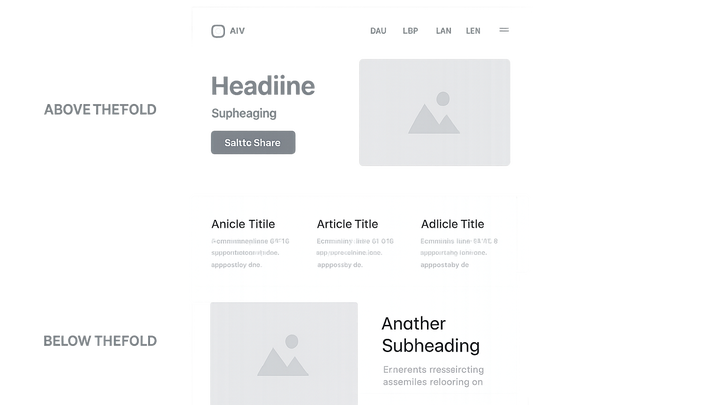Published on 2025-06-29T19:25:03Z
What is Above the Fold? Understanding Above the Fold in CRO, UX & SEO
Above the fold refers to the portion of a webpage that users see immediately upon landing, before any scrolling occurs. The term originates from print media, where the most important headlines and stories appeared on the upper half of a newspaper, visible when it was folded. In web design and digital marketing, this area is critical for capturing attention, communicating value propositions, and guiding visitors toward conversion goals. A strategic above the fold layout can reduce bounce rates, boost engagement, and support SEO efforts by ensuring that essential content loads quickly and appears prominently. Key elements often include concise headlines, clear call-to-actions (CTAs), and intuitive navigation. Tools such as Prevue.me offer actionable critiques of above the fold designs, helping teams optimize for maximum lead generation, accessibility, and user satisfaction. By prioritizing load speed, responsive layouts, and visual hierarchy, businesses can create compelling above the fold experiences that speak directly to their audience’s needs.
Above the fold
The visible portion of a web page before scrolling; crucial for engagement, CRO, UX, and SEO.
Definition and Origin
The term “above the fold” originated in the newspaper industry, referring to the top half of a folded paper where the most important headlines were displayed. As web browsing emerged, designers adopted this concept to describe the portion of a web page visible without scrolling. Understanding its historical context helps illustrate why this space remains vital for capturing attention and conveying key messages quickly.
-
Historic background
In print media, newspapers were folded when displayed, making the upper half the most valuable real estate for headlines to drive sales.
-
Digital adaptation
On websites, ‘above the fold’ represents the screen area visible on page load, which can vary based on device, browser, and screen resolution.
Why Above the Fold Matters in CRO, UX, and SEO
Leveraging above the fold effectively can significantly impact conversion rates, user satisfaction, and search engine performance. This section examines how first impressions shape behaviors and metrics across CRO, UX, and SEO disciplines.
-
User engagement
First impressions formed above the fold influence whether visitors stay or leave, affecting metrics like bounce rate and time on page.
-
Conversion rate optimization
Placing compelling offers and CTAs above the fold can boost click-through rates and overall conversions in A/B tests and campaigns.
-
Seo considerations
Search engines value load speed and user experience; optimizing above the fold content for fast rendering and relevance supports better rankings.
Best Practices for Designing Above the Fold
Implementing best practices ensures that content above the fold captures attention and drives action. Focus on clarity, speed, and responsiveness.
-
Clear value proposition
Use concise headlines and subheadings to communicate the main benefit or solution within seconds.
-
Prominent cta
Ensure calls to action are visually distinct, actionable, and positioned where they can’t be missed.
-
Visual hierarchy
Arrange elements using size, color, and whitespace to guide the eye toward key messages and actions.
-
Responsive design
Design layouts that adapt fluidly to various screen sizes, ensuring the above the fold area remains effective on desktop and mobile.
Common Pitfalls to Avoid
Avoid mistakes that can undermine the impact of your above the fold content. Recognize issues that lead to user frustration and missed opportunities.
-
Cluttered layout
Overloading the space with too many visuals, text, or options can overwhelm users and obscure your main message.
-
Slow load times
Large images, videos, and unoptimized scripts above the fold can delay page load and drive visitors away.
-
Ignoring mobile viewports
Failing to test above the fold on mobile devices can result in cut-off content or poor user experiences for the majority of users on smartphones.
Tools and Examples
Utilize specialized tools and real-world examples to analyze and improve your above the fold area. Here are some resources to get started.
-
Prevue.me actionable critiques
prevue.me evaluates your above the fold content alongside broader UX, CRO, SEO, and accessibility factors, offering specific recommendations to boost lead generation.
-
Analytics tools
Google Analytics scroll depth reports and heatmapping services like Hotjar show how users interact with content above the fold.
-
A/b testing platforms
Platforms such as Optimizely and VWO enable experiments on different above the fold layouts to find the highest performing variations.
